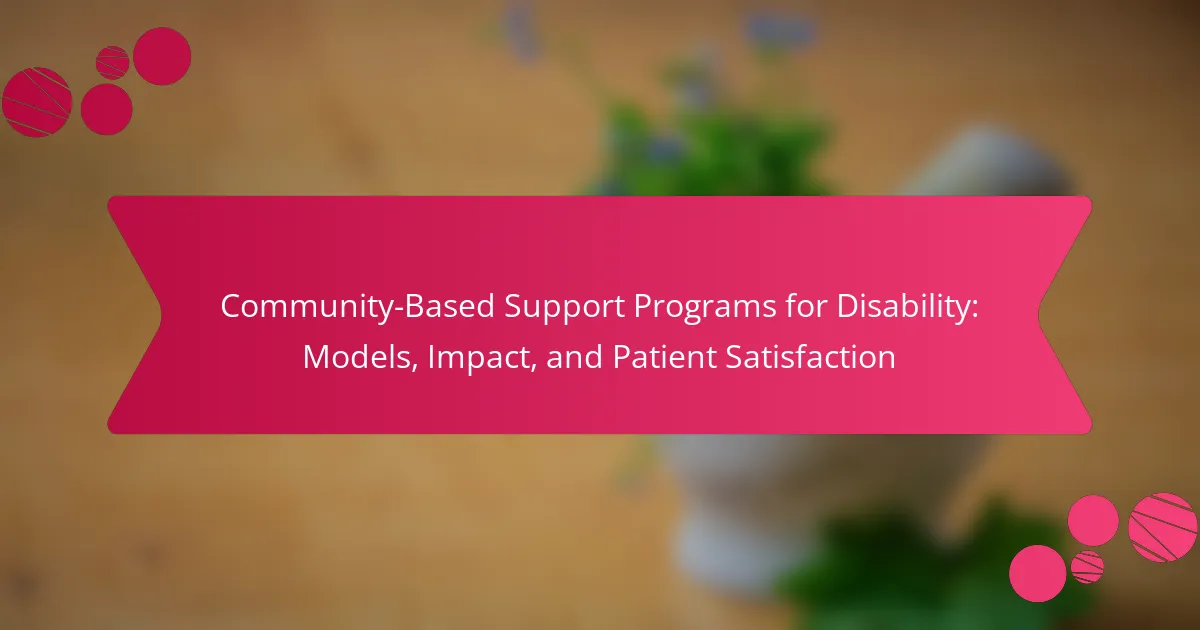Community-based support programs for disability enhance quality of life by promoting independence and social inclusion. Key models include the social model, person-centered approach, and strengths-based model. These frameworks influence patient satisfaction through accessibility, quality of care, and emotional support. Addressing challenges like funding and staff training is essential for improving program effectiveness and participant engagement.
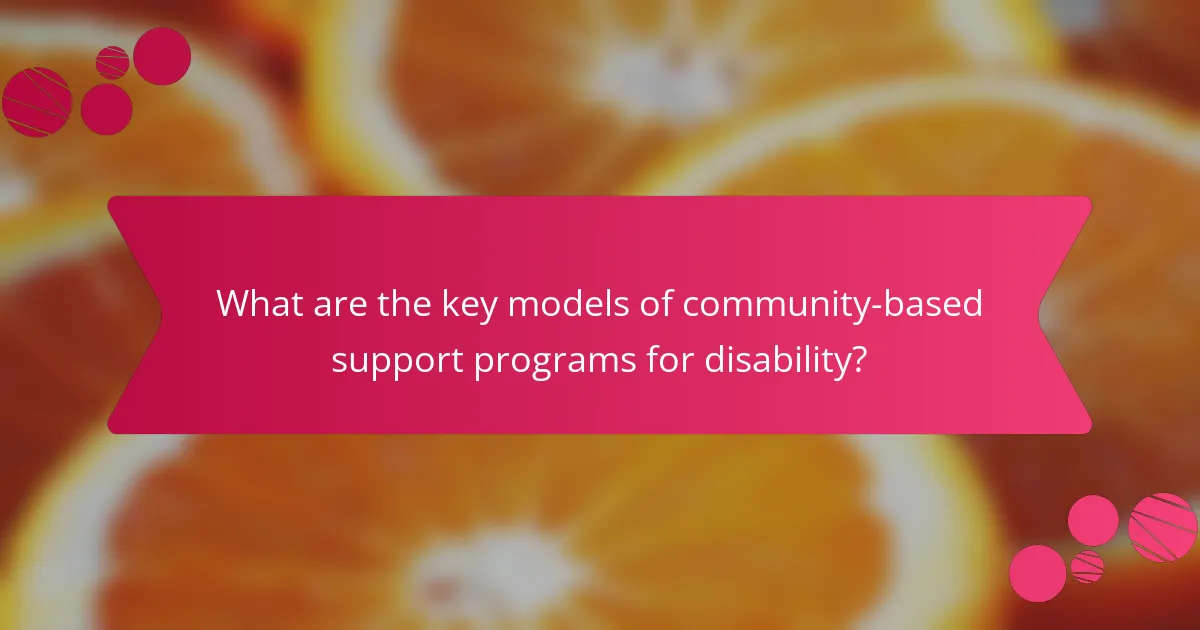
What are the key models of community-based support programs for disability?
Key models of community-based support programs for disability include the social model, the person-centered approach, and the strengths-based model. These frameworks focus on enhancing individual autonomy, promoting social inclusion, and leveraging community resources. The social model emphasizes societal barriers, while the person-centered approach tailors support to individual needs. The strengths-based model highlights personal capabilities and community assets. Each model impacts patient satisfaction by fostering empowerment and improving quality of life.
How do integrated service delivery models enhance patient outcomes?
Integrated service delivery models enhance patient outcomes by fostering collaboration among healthcare providers, improving access to services, and tailoring care to individual needs. These models, such as community-based support programs for disability, create a holistic approach that addresses physical, emotional, and social aspects of health. Research indicates that patients experience higher satisfaction and better health results when services are coordinated effectively. Additionally, these programs often lead to reduced hospitalisations and improved quality of life by ensuring continuous support and resources are available.
What role do peer support networks play in community-based programs?
Peer support networks significantly enhance community-based programs for disability by fostering connection and shared experiences. They provide emotional support, practical advice, and resources, improving patient satisfaction and outcomes. Additionally, these networks facilitate empowerment, enabling individuals to advocate for their needs. Research indicates that participants in peer support programs report higher levels of engagement and satisfaction compared to traditional support methods.
Which innovative approaches are emerging in community support for disabilities?
Innovative approaches in community support for disabilities include technology integration, peer support networks, and personalised care models. These strategies enhance accessibility, foster social inclusion, and improve patient satisfaction. For instance, telehealth services provide remote support, making healthcare more accessible. Peer-led initiatives empower individuals with disabilities, creating a sense of community and shared experience. Personalised care models focus on individual needs, ensuring tailored support that addresses unique challenges. These approaches collectively drive positive outcomes in community-based disability support.
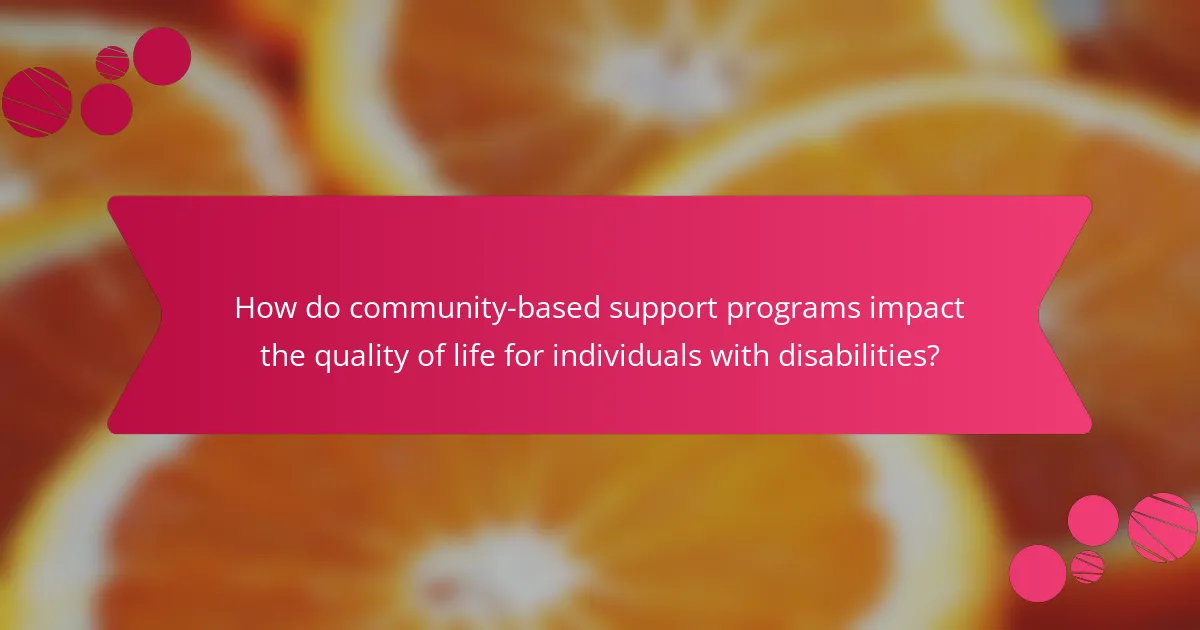
How do community-based support programs impact the quality of life for individuals with disabilities?
Community-based support programs significantly enhance the quality of life for individuals with disabilities. These programs provide essential resources, foster social connections, and promote independence. Research indicates that participants experience improved mental health, increased self-esteem, and greater community integration. For example, programs offering peer support and skill-building workshops often lead to higher satisfaction rates among individuals with disabilities. Additionally, access to tailored services can reduce feelings of isolation, thus enhancing overall well-being.
What metrics are used to evaluate the effectiveness of these programs?
Community-based support programs for disability effectiveness is evaluated using various metrics. Key metrics include patient satisfaction surveys, service utilisation rates, outcome measurements, and cost-effectiveness analyses.
| Metric | Description |
|—————————-|————————————————–|
| Patient Satisfaction | Measures user contentment with services provided |
| Service Utilisation Rates | Tracks frequency and type of services accessed |
| Outcome Measurements | Assesses improvements in health and quality of life |
| Cost-Effectiveness Analysis | Evaluates financial efficiency of the programs |
How do community support programs influence social inclusion and participation?
Community support programs significantly enhance social inclusion and participation for individuals with disabilities. These programs offer tailored resources and opportunities that empower individuals to engage in their communities.
Research shows that community-based support initiatives improve access to social networks and activities, fostering a sense of belonging. For instance, programs that facilitate peer interactions can lead to increased participation in community events and activities.
Additionally, patient satisfaction is often linked to the effectiveness of these programs. Individuals report feeling more valued and included, which enhances their overall quality of life.
Ultimately, the impact of community support programs is profound, as they create environments where individuals with disabilities can thrive socially and actively participate in their communities.
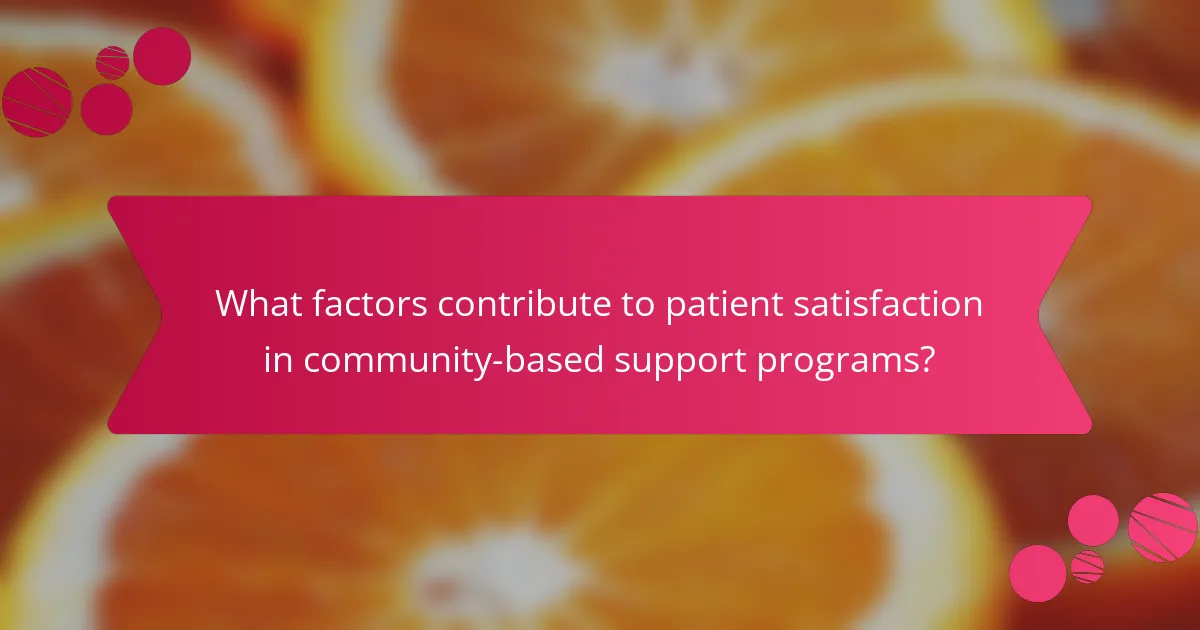
What factors contribute to patient satisfaction in community-based support programs?
Patient satisfaction in community-based support programs is influenced by accessibility, quality of care, communication, and emotional support. Accessibility ensures that services are easy to reach and use. Quality of care reflects the effectiveness and professionalism of the support provided. Communication involves clear and empathetic interactions between patients and providers. Emotional support addresses the psychological and social needs of patients, enhancing their overall experience.
How does accessibility affect user satisfaction across different regions?
Accessibility significantly enhances user satisfaction across regions by addressing diverse needs. Improved access to community-based support programs for disability leads to higher patient satisfaction. For instance, programs tailored to local cultural contexts often yield better engagement and outcomes. Additionally, regions with robust accessibility frameworks report increased community participation, fostering a sense of belonging and empowerment among individuals with disabilities.
What feedback mechanisms are most effective in assessing patient experiences?
Surveys and focus groups are the most effective feedback mechanisms for assessing patient experiences in community-based support programs. These methods allow for direct input from patients, fostering a deeper understanding of their needs and satisfaction levels. Surveys provide quantitative data, while focus groups offer qualitative insights, revealing unique attributes of patient experiences. Regularly implementing these mechanisms can enhance program impact and patient satisfaction.
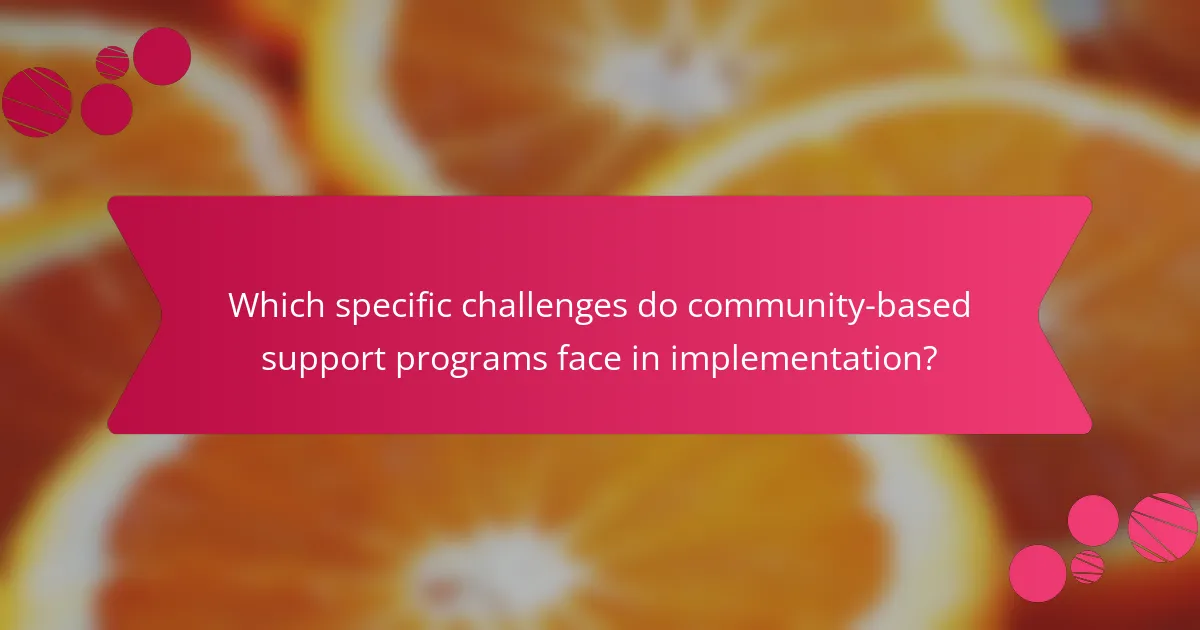
Which specific challenges do community-based support programs face in implementation?
Community-based support programs for disability face challenges such as funding limitations, staff training issues, and coordination among stakeholders. These obstacles hinder effective implementation and reduce patient satisfaction. Additionally, varying community needs complicate program adaptation. Addressing these challenges is crucial for enhancing program impact and overall effectiveness.
How do funding and resource allocation impact program effectiveness?
Funding and resource allocation significantly influence the effectiveness of community-based support programs for disabilities. Adequate funding ensures access to necessary services, staff training, and program sustainability. Programs with higher resource allocation often report better patient satisfaction and improved outcomes. Research indicates that effective allocation of funds directly correlates with the quality of care provided, emphasizing the need for strategic financial planning to enhance program impact.
What barriers exist in reaching underserved populations?
Barriers in reaching underserved populations include lack of awareness, limited access to services, and cultural differences. These factors hinder the effectiveness of community-based support programs for disability. Access to transportation and financial constraints also contribute to the challenges. As a result, patient satisfaction may decline due to unmet needs.

What are the best practices for designing effective community-based support programs?
Effective community-based support programs for disability should prioritise inclusivity, accessibility, and participant feedback. Key best practices include engaging individuals with disabilities in program design, ensuring services are tailored to diverse needs, and fostering partnerships with local organisations. Regular evaluation of program impact enhances patient satisfaction and adjusts services based on community feedback. Training staff on disability awareness and cultural competence further improves service delivery, creating a supportive environment that empowers participants.
How can stakeholder collaboration enhance program success?
Stakeholder collaboration significantly enhances program success by fostering shared goals and resources. Engaging diverse stakeholders, including community members, service providers, and policymakers, promotes a holistic approach to program development. This collaboration leads to improved resource allocation, ensuring that programs are tailored to meet the specific needs of individuals with disabilities.
Moreover, collective input from stakeholders can enhance program credibility and visibility, attracting more participants. Research shows that community-based support programs with active stakeholder involvement report higher patient satisfaction rates, reflecting the importance of inclusivity in program design. By leveraging various perspectives, programs can adapt to changing needs, ultimately increasing their effectiveness and sustainability.
What strategies can improve outreach and engagement with the community?
Implementing community-based support programs enhances outreach and engagement effectively. Strategies include fostering partnerships with local organisations, utilising social media for awareness, and hosting community events to build relationships. These approaches increase visibility, trust, and participation among community members. Engaging individuals with disabilities in program design ensures relevance and satisfaction, ultimately leading to improved outcomes.
What common mistakes should be avoided when implementing these programs?
To avoid common mistakes when implementing community-based support programs for disability, focus on clear communication and stakeholder engagement. Failing to involve individuals with disabilities or their families can lead to misaligned services. Additionally, neglecting to evaluate program effectiveness can hinder improvements. Inadequate training for staff may result in poor service delivery. Lastly, overlooking cultural sensitivity can alienate participants.
